The face of the two cities.
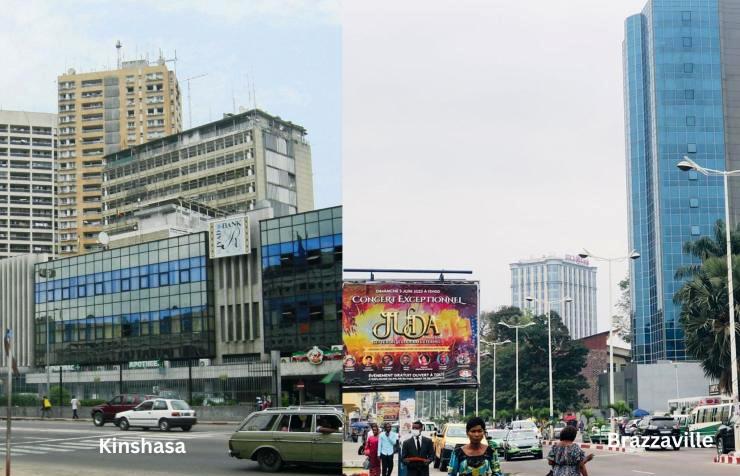
Kinshasa is the capital and largest city of the Democratic Republic of the Congo. It is experiencing a demographic explosion due to a still high birth rate and migratory flows encouraged by rural poverty and the insecurity of war zones.
Today, Kinshasa has 17.07 million inhabitants. It is currently the third most populous city in Africa, after Cairo in Egypt and Lagos in Nigeria. It has 24 municipalities. It is considered the largest French-speaking conurbation in the world, having surpassed Paris.
Kinshasa is everyone’s favourite centre of attraction and opportunity, especially for young people. As a business centre that controls the majority of activities, the capital is renowned for its prosperity within the country and is a bridge that connects DR Congo with other countries.
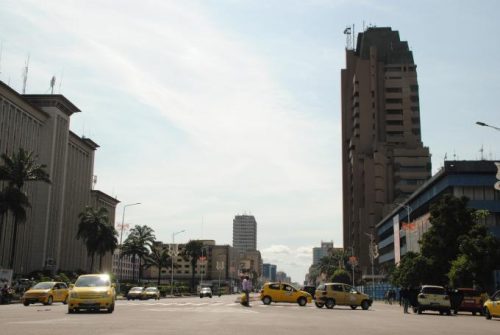
Kinshasa’s Boulevard du 30 Juin. The city has 17.07 million inhabitants. Photo: Lwanga Kakule
“Today, like many African cities, it is seen as the place where all hopes come true. Everyone hopes for something good for themselves and for those around them. It is mainly young people who go there to study (especially at university), in search of economic abundance, electric light, and employed work”, explains Professor Jean-Pierre Bwalwel of the Catholic University of Kinshasa.
Others move to the capital for trips within and outside the country, for medical treatment and so forth.
Finally, it often happens that their goals change and they decide to settle in ‘Kin la Belle’, where music and light shows abound.
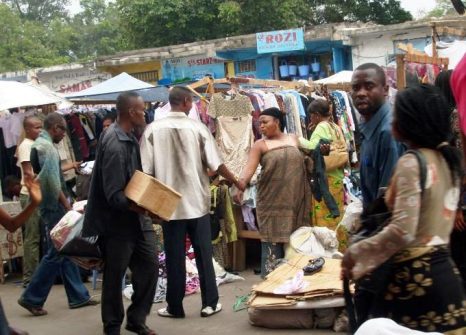
Kinshasa. Market. The capital is renowned for its prosperity. File swm
But life is difficult for many people. Thousands of families survive in cramped accommodation with poor hygienic conditions, malnutrition, and transport problems. Despite this, the population of Kinshasa is recognized for its dynamism and resilience. They strive to create a tone of joy and what they call ‘atmosphere’. They are known for their hospitality and constant human warmth. In most cases, they rely on themselves to solve their problems.
On the other side of the river, Brazzaville today has a population of 2.5 million, out of 5.4 million in the entire country. Congo-Brazzaville is one of the most urbanized countries in Africa, with almost 70% of the Congolese population living in urban areas, resulting in an urban-rural imbalance and poor agricultural, livestock, and fisheries production.
The population is concentrated in the south-west of the country, mainly in Brazzaville, the capital and Pointe-Noire, the financial capital and along the railroad that links the two largest cities in the country.
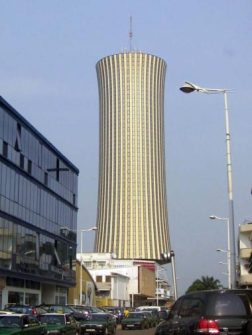
Nabemba Tower in Brazzaville. The capital has a population of 2.5 million. Photo: Lwanga Kakule
Brazzaville began to develop during the decolonization process, particularly when the new authorities decided to make it the official capital, to the detriment of Pointe-Noire. But in the first half of the 1970s the country fell into a deep economic crisis when the International Monetary Fund and the World Bank reduced aid and credits, forcing the government to make a series of budget cuts, especially in social spending.
Transport infrastructure was progressively abandoned and all urbanization policies, such as access to drinking water, electricity, healthcare, and education, were reduced to almost nothing.
The civil war in the Republic of Congo from 1997 to 1999 was particularly ruthless, and Brazzaville was the centre of fighting between the late president Pascal Lissouba and the current president
Denis Sassou Nguesso.
Poto Poto is one of the oldest neighbourhoods in Brazzaville. It is currently the centre of important companies and businesses. Since its foundation, the capital has welcomed many foreigners. Senegalese, Malians, Togolese, Beninese, Burkines, Nigerians, and Guineans who had accompanied Savorgnan de Brazza and settled in Brazzaville. Many of them never returned to their homeland and some became naturalized Congolese. For decades they specialized in fishing and trading and had virtually unchallenged dominance over trade in Congo-Brazzaville. Now they are gradually entering into competition with the Congolese of the DRC, the Chinese, and the Indians.
Trade between Kinshasa and Brazzaville
Due to their proximity and high population concentration, Kinshasa and Brazzaville have generated a significant volume of commercial exchange. Traders from both banks cross the river to stock up and do business. According to analysts, informal cross-border trade represents a very high percentage of trade between the two capitals. Food products are by far the largest items of trade between the two populations.
From Kinshasa, fish, cassava, palm oil, coffee, frozen chicken, spaghetti, and biscuits are unloaded in Brazzaville. Some of these products come from within the DRC, especially from the provinces of Kwilu,
Kwango, and Maindombe.
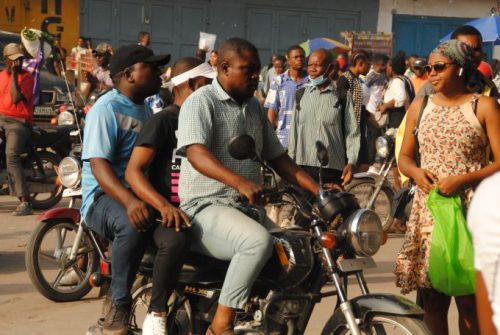
A group of people in the street at Pompage. The population of Kinshasa is recognized for its dynamism and resilience. Photo: Lwanga Kakule
The FIMA pier and the port of Yoro are the supply points for the people of Brazzaville, while the Ngobila beach serves the inhabitants of Kinshasa. The latter import clothes and fabrics from Brazzaville, mainly wax fabrics made in the Republic of Congo which they then sell in the provinces of Ecuador and Kasai, and in the rest of the country across the river.Judith Singa is from Pointe Noire, the second largest city in Congo-Brazza. A 40-year-old widow and mother of three children, she runs a shop in Poto Poto where she has lived for 11 years: “I made regular return trips from Brazzaville to Kinshasa”, she explains. “I used to buy frozen chickens and the business was thriving. Four years ago, I changed my business: I opened a fabric shop. Most of my customers are from Kinshasa”.In 2021, Brazzaville writer Gaston M’Bemba-Ndumba published a book titled ‘Femmes et petits commerces du fleuve Congo entre Brazzaville et Kinshasa’, in which he analyses small-scale trade and exchanges between women in both cities. As a result of observations, he discovered that most of the products used for skin whitening, for example, come from Kinshasa and those who sell them in Brazzaville are women who have used these products. According to his analysis, small women’s trading is the most representative part of the commercial sector between Brazzaville and Kinshasa, which, for the most part, remains informal. Its commercial activities focus on catering, the sale of fresh food and clothing.
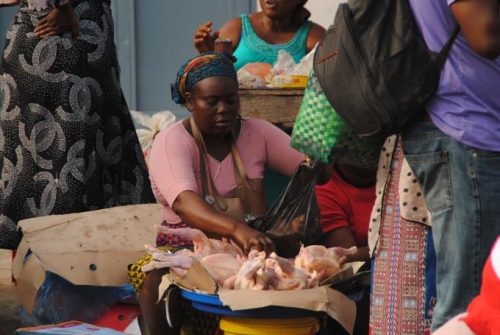
A woman selling chicken in Pompage, Kinshasa. Photo: Lwanga Kakule
At Port Nzimbi, named after a former army general of Mobutu, in Kinshasa, around 50 women from the capital display pondu ‘hard leaves’, a staple food in the country, which they buy wholesale on the islands of the Congo River and they retail it early in the morning.
Maman Nicole, 43, mother of four, explains: “For six years I have been selling pondu, cassava and sometimes tomatoes and aubergines. Almost every day I take a motorized pirogue. Sometimes I make a crossing to Brazzaville, where I have some customers. It is thanks to this work that I can send my children to school”. The police officer, who monitors the movements of the pondu sellers, tells us that she has been working for over ten years in various border posts along the Congo River, confirming that most of the small trade on the Congo River between the two capitals is carried out by women.
Trade between the two capitals has given rise to jobs for people such as salesmen, porters, loaders, truck drivers, mechanics and so on.
Ports on both sides of the border have also become notorious for organized smuggling, sometimes with the complicity of government officials from customs and other enforcement services. Many goods – fabrics, minerals, fuel, coffee, etc. – cross the river without paying taxes. This is without taking into account the clandestine passage of migrants on both sides. (L.K.)



